You will see from Progress Report 7, that I use a sump for the end of the stream, rather than having a pond. Firstly, this part of the garden is shaded from the sun by the house and so a pond would receive insufficient sunlight to keep it healthy. And secondly, I did not fancy having a breeding ground for mosquitoes so close to the house.
Initially for the stream bed, I purchased a fibreglass, ready-formed stream, complete with pump. It was OK as a temporary measure but when I realised I would need to bed it into the landscape, I recognised its limitations. It was also very expensive and very short.
I then consulted various books and websites. I had originally intended to construct the bed of the stream entirely from concrete, but the books suggested this was not advisable as it cracks easily and ceases to be watertight. Ready-made plastic or resin sections of waterfall and stream seemed horrendously expensive - I worked out that even a short two metre stream would cost over 600 GBP (at 2006 prices). Using PVC or rubberised pond-liner seemed a better option, but would be difficult to blend into the landscape. Eventually, I opted for the method described below which aims to combine the reliability (and cost effectiveness) of a flexible liner with the creative potential of concrete. I have had one section in place for over a year now and it seems to be weathering nicely (UPDATE 2018 - the stream has been in place for twelve years now, and so far, so good).
The photos for this post show an extension I added to the original stream.
Stage 1
I planned where the stream will flow - making sure there was a gentle fall from top to bottom.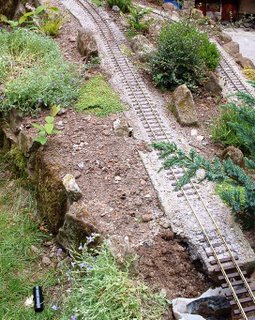
At the bottom of this photo, you can just see the top of the original stream. Also, you can see the junction-piece ready for extending the pipework.
Stage 2
I dug out the bed for the stream with a trowel, digging approximately 6 inches (15cm) deeper than the actual stream bed.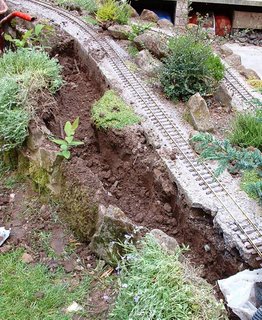 You can see I also chiselled into to blocks supporting the trackbed as I needed more width for the stream at this point.
You can see I also chiselled into to blocks supporting the trackbed as I needed more width for the stream at this point.
Stage 3
The pipework is laid at the bottom of the trench. You may prefer to lay this to one side, in case leaks need to be repaired. I'm working on the principle that plastic pipes are almost indestructible and are more likely to be damaged by careless digging - hence laying them beneath the stream itself where there will be no digging.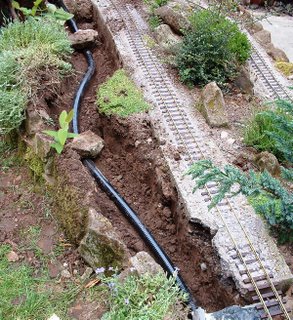
The rocks are there to hold it down for the photo and were removed during the next stage.
Stage 4
Soft sand was laid over the pipe, to provide a bed for the stream. Where possible, it was moulded up the sides of the stream to ensure sharp stones don't puncture the liner.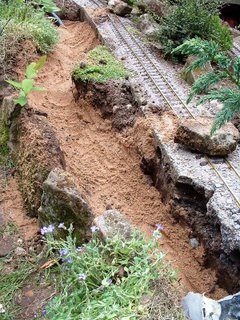
Stage 5
I used some foam packaging which was wrapped around some electrical good to act as an additional cushion for the liner. This is not essential but I had it to hand and hate to see waste.......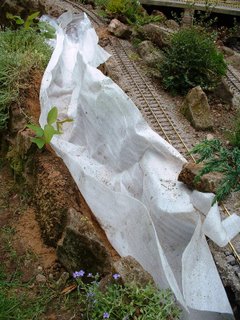
Stage 6
I next laid the liner which as you can see is initially much wider than it needs to be - easier to cut of excess than try to extend something which is too narrow.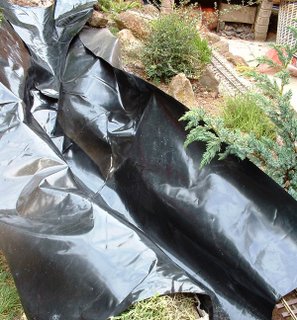
Stage 7
Now came the creative part. I carefully selected chunks of sandstone to line the sides of the stream. Because the stream was very narrow, I had to cleave some of the blocks. I suppose you could use pebbles, stones or gravel but as I had some chunks left over from building the rockery I used these - and it ties in with the locality.
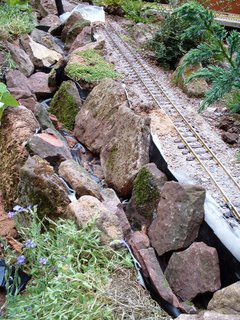
Once I was happy with the position of the rocks (and this took more than a little trial and improvement), I trimmed back the excess plastic liner and the foam 'underlay'.
I then tested the stream by turning on the pump. When making the original stream, I had to test it by pouring water from a bucket as the pump I had then was too weedy. I quickly realised the flow was going to be too great for this new narrower stream and so decided to split the pipe at the point I had joined the new length to the old. I now have an outlet flowing into the original stream and an outlet flowing into the new stream.
Stage 8
The messy bit! I donned a pair of rubber gloves for this - I prefer the 'hands-on' method. A mix of 4 parts sand to 1 part cement was slapped, slopped and splodged behind, under and between the rocks to fill the cracks, provide a bed for the stream and, in places, create some new rocky outcrops. If I hadn't had any rocks, I could probably have moulded my own from concrete. I use an old 2" household paintbrush to smooth down the cement - it can also provided in interesting finish if it is stippled on the surface. When concrete is 'green' (ie when it has partially dried out but before it is hard) it can be sculpted and scribed.
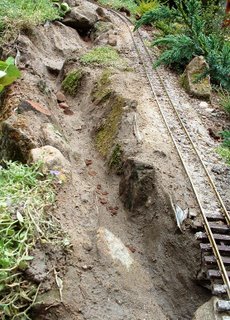
I tend to then leave it for at least a week to harden. If the heatwave had continued, I would have covered the concrete with damp cloths to prevent it from drying out too quickly. Similarly, if it rained heavily I would have covered it with polythene.
Conclusion
I have no idea how durable this approach will be - a hard winter might result in some frost damage. However, I anticipate it will be relatively easy to repair any cracked concrete and the liner should prevent leakage (should!).
Views of the stream
The new extension
Where the new joins the old
The original stream
Update - July 2012
Over the past six years, the stream has become blended into the landscape. Moss and Mind Your Own Business (aka Baby's Tears) now line the banks and dip into the flow, giving the stream a more natural look.



From time to time I have to clear out the waterways of encroaching undergrowth - but this takes only a few minutes a couple of times a year. There is some seepage of water, which means that if I run it for around half a day I have to top it up with around a gallon of water. I can't figure out where the water is escaping as nowhere seems to become soggy, but this rate of seepage is something I can live with.
I am now considering adding a mill beside the main stream. It will be positioned on the further bank and will require its own dedicated siding - similar to that found on the Southwold Railway. As it will be on the furthermost bank of the stream I will need to build a bridge - and a simple timber trestle seems the most appropriate (again similar to that on the Southwold. I am also interested in building a fairly realistic mill race and sluiced leat to feed the mill. I'd like to be able to regulate the water flow in some way so the wheel doesn't end up spinning madly (and unrealistically) - but that may prove more difficult than I imagine!
Update - April 2014
The planned mill siding has now been added (see How I constructed the mill siding)
UPDATE - July 2017
After supposing that I had a leak in the stream (which there wasn't), I remodelled the section of the stream beside mill (see How I revamped part of the stream). I widened the stream here and incorporated a small section of mill-stream, ready for the installation of the mill building
UPDATE - November 2017
The mill has now been constructed and a sluice gate added to control the flow of water to the wheel.
The stream has been in operation now for over twelve years and, as far as I can tell, has not sprung a leak, so it would seem that this system is fairly watertight (in both senses). A couple of times I suspected there was a leak but it turned out that the perforated lid of the dustbin through which the water returns to the sump get clogged with debris and so the water overflows rather than recycling. I now clean out the sump twice a year and find there is still very little water loss while running the pump.
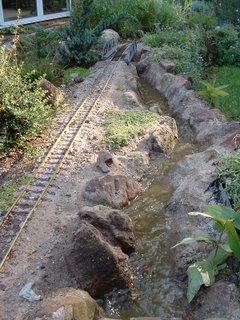

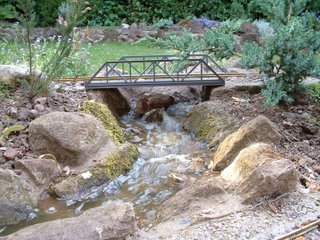








19 comments:
Hi Rik, nice site. I like the way you've incorporated the stream bed into the overall landscaping; it looks totally natural even now.
I haven't had a chance to look at the rest of the blog yet, but I've book-marked it for a return visit or 3.
Cheers
Clive
Thanks Clive
Not seen anyone else using this technique. I visited various garden centres and costed ready-made stream sections which made me (and my wallet) shudder so I just experimented. Concrete alone is far too problematic when it comes to waterproofing and loose stones/rocks on plastic liner never seems to look that realistic. This seemed to be the best of both worlds - and so far it seems to have survived.
It's important to make sure the liner is run into the pond or sump at the foot of the stream as water does seep through - but most stays in the stream. You also need to buy the most powerful pump you can afford - you can always put a flow restrictor in of it's too powerful. I found one in a sale but it still cost me about £50. It was worth it, though.
Hi Rik,
In the video you show the burried bin, do you have a blog post which describes that part of the works.
Thanks,
Bo
Hi Bo
Sorry, I've not blogged how I buried the bin. Basically, I dug a hole deep enough and wide enough to take the bin, dropped it in and then filled in any gaps around it with soil. I made sure the bin was slightly lower than the level of the soil and concreted a funnel-shaped section to bring it up to soil level. I drilled holes in the lid of the dustbin, inverted it and place it on top of the bin. It's important to make sure the liner of the stream overlaps the inverted lid so that any water which seeps through the concrete in the stream bed runs back into the bin.
Hope that helps
Rik
This is very impressive. I plan to make a complete fairy village and I want to incorporate a running stream. It will be about 6 feet long. Thanks for the videos!
Christine McMain
#Christine McMain said...
This is very impressive. I plan to make a complete fairy village and I want to incorporate a running stream. It will be about 6 feet long. Thanks for the videos!
Christine McMain
Thanks Christine. Overall, my stream is about 8ft long, so you should have no problem. If you want a good flow, buy a decent pump. Mine cost around £75, but that was in a sale. I think pumps may have dropped in proce since I bought mine so you might get a reasonably powerful one for about that price now. I originally had a weedy little pump and the flow was little more than a trickle.
Rik
You made a beautiful and very natural looking stream, congratulations!
Have you considered turning the dustbin covered with pebbles into a very small pond? That would look very nice and add realism.
Thanks Calin
It did occur to me. In fact, I had thought of turning the whole patio area into a pond. Trouble is, mosquitoes love me - I get eaten alive - and the thought of having a pond just outside the house where they would probably breed like crazy seemed my worse nightmare.
Rik
Rik-
Fantastic job, I'm looking to do something similar on my layout. A few questions:
-does the stream run continuously?
-is it only fed from the sump pump recycling water back upstream or is there another source of flow, maybe a hose?
-my layout is on a lower tier lot away from our house with a slope down into brush. I'm wondering if I can avoid the pump altogether and just have the stream fed by a hose up top and drain into the brush at the bottom of the layout. Turn it on when I'm running the trains, turn it off when I'm done. Thoughts?
Hey Rik-
Absolutely incredible job. I will be following your guidelines in doing something similar in my layout. A few questions:
-does the stream run continuously or only when you are running trains?
-does the entire flow come from the sump pump or do you feed it up top, maybe with a hose?
-for my layout, I’m working on a remote plot below our house. There is a gentle slope running downhill into a large area of brush. I’m wondering if I could just put a hose up top and have the stream drain into the brush below and avoid the pump altogether. Thoughts?
Note I tried to post this before, not sure it worked. Thanks for your thoughts.
Hi Bob
I only run the stream when I'm running trains (or if we have a barbecue etc.), but a mate who has made a similar stream runs his all the time without any problems.
Yes, it needs topping-up after each time I run it. Not sure where it's leaking but I suspect a tiny amount leaks over the edge at one point and all those tiny amounts add up.
Personally, I prefer to use a pump to recycle the water. I've not calculated, but I think you'd use a heck of a lot of water in a few hours if it was just draining away, particularly if you wanted decent flow in the stream.
Thanks Rick, I’ve come to that same conclusion. How did you go about sizing your pump?
Not very scientific, I'm afraid. My local aquatic garden centre had some on offer for £50, so I bought one. Basically, I went for the most expensive I could afford at the time.
Rik
In terms of flow rate, I figured I could always put a flow restrictor in the pipe if it was too vigorous, whereas I couldn't increase the flow if it was too feeble.
Rik
Makes sense thx
Did you simply cut off the foil or install a so-called capillary barrier?
Hi Robert
Not quite sure what you mean. I've not used foil nor a capillary barrier - just polythene stream liner and some plastic packaging material to act as a cushion beneath the liner.
Rik
Greetings from Middle Tennessee! I'm new to garden railroading and have learned so much from your posts and videos! Do you recall the gallons per hour output of your pump? Thank you for sharing your modeling experiences!
Hi Ken I can't remember the flow rate, sorry. Basically, I bought the most expensive pump I could afford. Mine cost 75GBP and that was in a sale so will probably have been around 100GBP. If you get one which is too powerful, you can put a flow restrictor in to slow it down whereas you can't increase the flow of a weak pump. Somewhere, I do remember answering a question on the flow rate and tracked it down. I'll check through my comments and let you know if I do find it.
Post a Comment